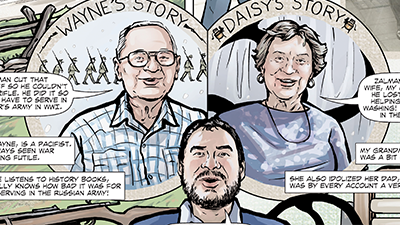History and Memory
Teacher Resources
Driving Question: How does history shape our societies and the ways we think about ourselves?
History and memory are often intertwined, even though each serves different purposes and different perspectives. Your job as a historian-in-training is to decide how to assess historical narratives by analyzing evidence. But what happens when evidence is tied to a person’s memories of events or to our collective memory?
Learning Objectives:
- Explain the difference between history and memory.
- Understand how collective learning impacts our past, present, and future.
- Develop the skills and vocabulary needed to read graphic histories.
Vocab Terms:
- collective learning
- gutters
- memory
- perspective
- symbolic langauge
Opener: History and Memory
To teach this lesson step, refer to page 2 of the Lesson 1.4 Teaching Guide.
Our perspectives can impact the meaning of what we read, see, and hear. This important understanding doesn’t just apply to history—it’s true for any kind of critical thinking.
Graphic Biographies
To teach this lesson step, refer to page 3 of the Lesson 1.4 Teaching Guide.
Want to know more about our historical comics? Check out the Graphic Biographies Guide.
Throughout this course, you'll explore graphic biographies—one-page stories about historical figures that offer fresh perspectives on history. The activities below will show you how to read them.
The Purpose of Memory and History
To teach this lesson step, refer to page 3 of the Lesson 1.4 Teaching Guide.
Make sure to modify, adapt, and differentiate throughout this lesson. The OER Project Differentiation Guide has some great tips for how to do this!
Now that you’re comfortable with comics, dive into a graphic biography that explores the difference between history and memory—and shows how each serves a unique purpose.
-
Guiding Questions
-
Before you read
Preview the questions below, and then skim the comic, paying attention to things like prominent colors, shapes, and types of text and fonts. How do you know where to start and in which direction to read? What’s in the gutters (the space between panels)? Who or what is the focus of the comic?
While you read
- What factors may have influenced how Wayne and Daisy remembered the story of Zalman’s finger differently?
- What factors influence Trevor’s analysis of these stories?
- What evidence does Trevor cite for how Zalman may have lost his finger?
- “Memory and history often serve different purposes and have different perspectives.” What do you think this last line of the graphic biography means?
After you read
Respond to this question: If you had to decide which story about Zalman’s lost finger is most historically accurate, which version would you choose?
Sharing and Telling History
To teach this lesson step, refer to page 4 of the Lesson 1.4 Teaching Guide.
Want some teacher takes on collective learning? Look no further than this conversation.
The study of history relies on our ability to share and pass down stories across generations. In this course, we call this power collective learning.
-
Guiding Questions
-
Before you watch
Preview the questions below, and then review the transcript.
While you watch
Look for answers to these questions:
- What is collective learning?
- How is collective learning important to the history of humanity?
- Why is symbolic language important to collective learning?
- What are some negative impacts of collective learning?
After you watch
Respond to these questions: Can you think of an example from your life where you learned something from someone older than you? What was it, and where did they learn it?
Key Ideas
Closer: History and Memory
To teach this lesson step, refer to page 5 of the Lesson 1.4 Teaching Guide.
Remember that closers are a great opportunity to informally assess student understanding. Read more about this in the OER Project Assessment Guide.






